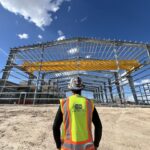In 1999, the Construction Industry Institute (CII) published a report titled “A Comparison of U.S. Project Delivery Systems.” This report evaluated the performance of design-bid-build (DBB), construction manager at risk (CMR) and design-build (DB) projects. The analysis revealed that design-build projects outperformed both CMR and DBB in terms of unit cost, cost and schedule growth, and all metrics relating to the speed of delivery. The CII recently reevaluated the most common construction delivery methods today, and design-build is still at the top. After 20 years, design-build projects are still being delivered faster and with greater reliability in cost and schedule performance.
Delivering all aspects of architectural design, engineering and construction

A Butler Manufacturing builder, Raleigh, N.C.- based Bobbitt Design Build has exemplified this for over 70 years.


More than just a commercial general contractor, Bobbitt prides itself on being a single entity contractually responsible for delivering all aspects of a project’s architectural design, engineering and construction. “Design-build offers time savings, monetary savings and reduced litigation through cultivating a solutions mentality and consistent collaboration,” says Bobbitt Design Build president Jim Bell, LEED AP. “With our architects and construction professionals under one roof, there is a greater feeling of teamwork and less finger pointing. The design elements, regulatory requirements and budgetary requirements [are integrated] into a cohesive process that delivers tremendous value to the building owner.”
Since bringing architecture in-house in the 1990s, Bobbitt uses what Bell calls “a fairly detailed process” starting with meetings concentrating on different project phases such as feasibility, conceptual, preliminary, construction documents and construction. Different team members sit in at different phases to ensure all know what the owner wants. “We even have preconstruction project managers who handle each of our projects to make sure everybody’s doing what they are supposed to do; the project is following the process, and the customer’s vision is being realized,” Bell says. “They keep the owner’s vision in mind for the project and ensure the whole project team is striving for success. That’s one of the things that make us different.”and service.
Building Relationships
One way Bobbitt has thrived for 70 years is by concentrating on delivering quality projects on time and within budget. “We focus on building relationships with our clients and subcontractors,” Bell says. “This is evident through over 70 percent of our projects being repeat customers or direct referrals. We place a high value on customer service and take pride in our overall impact in the communities we serve. A constant focus on long-term strategy has enabled us to maintain steady growth over the past 70-plus years. We have worked hard to develop a deep understanding of our vertical market sectors and provide our customers with outstanding quality and service.

The customers know they are getting a proven process that has been vetted with an experienced team of people who know what’s happening. Bobbitt has also concentrated in geographic regions that we know well. As a result, we’ve become a highly trusted resource across the Carolinas.”
Bobbitt values its relationship with its employees too. “As an employee stock ownership program (ESOP) company, our employee owners shape the culture and define the character of our company,” Bell says. “All Bobbitt employees pull for the same success, no matter their role.”
Metal Building Success
Metal buildings have helped Bobbitt Design Build grow in regards to schedule, cost and clear span solutions; they constitute approximately 50 to 70 percent of Bobbitt’s work each year. Bell says the metal building structural system is based on what the owner needs. “For flex building, warehouse and industrial environments, metal buildings’ clear span nature provides flexibility because there are not a lot of columns or load-bearing walls to deal with. Also, metal roofs provide low maintenance and are long lasting. It’s up there, you forget it’s up there and it’s good looking.”
Bell acknowledges the speed-of-installation component to metal buildings. “Our buildings can hit the ground around the time when the slab is done. [After that], the building comes together quite quickly. We can skin them quickly and so we [and other trades] are inside the buildings a lot faster versus conventional construction.” Also, Bell believes from a cost perspective, PEMBs are more economical than other forms of construction. “Standing seam roof systems don’t have a lot of weight on them. When it comes to metal buildings, we can provide a good, budget-friendly solution.”
Bobbitt Design Build completed a new sales and service center in Mebane, N.C., for Gregory Poole Equipment Co., a long-standing Caterpillar dealer for Eastern North Carolina. The 51,800-square-foot metal building will be used for sales and service of construction equipment,service of trucks and Caterpillar parts sales.

Bobbitt constructed a 33,029-square-foot facility to serve as the headquarters of a local Thermo King franchisee. The headquarters consists of office space, parts storage and delivery, work and wash bays and parking for more than 160 trailer units. The building has LED high-bay lighting, a 5-ton bridge crane system, a generator to power the entire building in the event of a natural disaster, and loading dock conditions for both 18-wheelers and pup trucks.
Bobbitt recognizes that green building directly benefits individual building owners through lower energy bills, lower water bills, longer-lasting buildings and healthier environments for occupants. A member of the U.S. Green Building Council, the company has 12 LEED accredited professionals and Green Associates on staff.
Bobbitt has set a goal to triple in volume. To help affect that change, Bobbitt is investing in technology to better communicate to internal employees and external subcontractors and owners. “We are using simple 3-D design in our architecture so we can show owners what projects look like so they can make decisions faster,” Bell says. “[Also, with this] our subcontractors can look can look for collisions between [mismatched] components like structures and sprinkler systems.”
Overall, Bobbitt continues to strive to show that design-build is the construction method of choice. “We want the whole industry to change and push in that direction. That’s our big, hairy audacious goal for 2030.”






